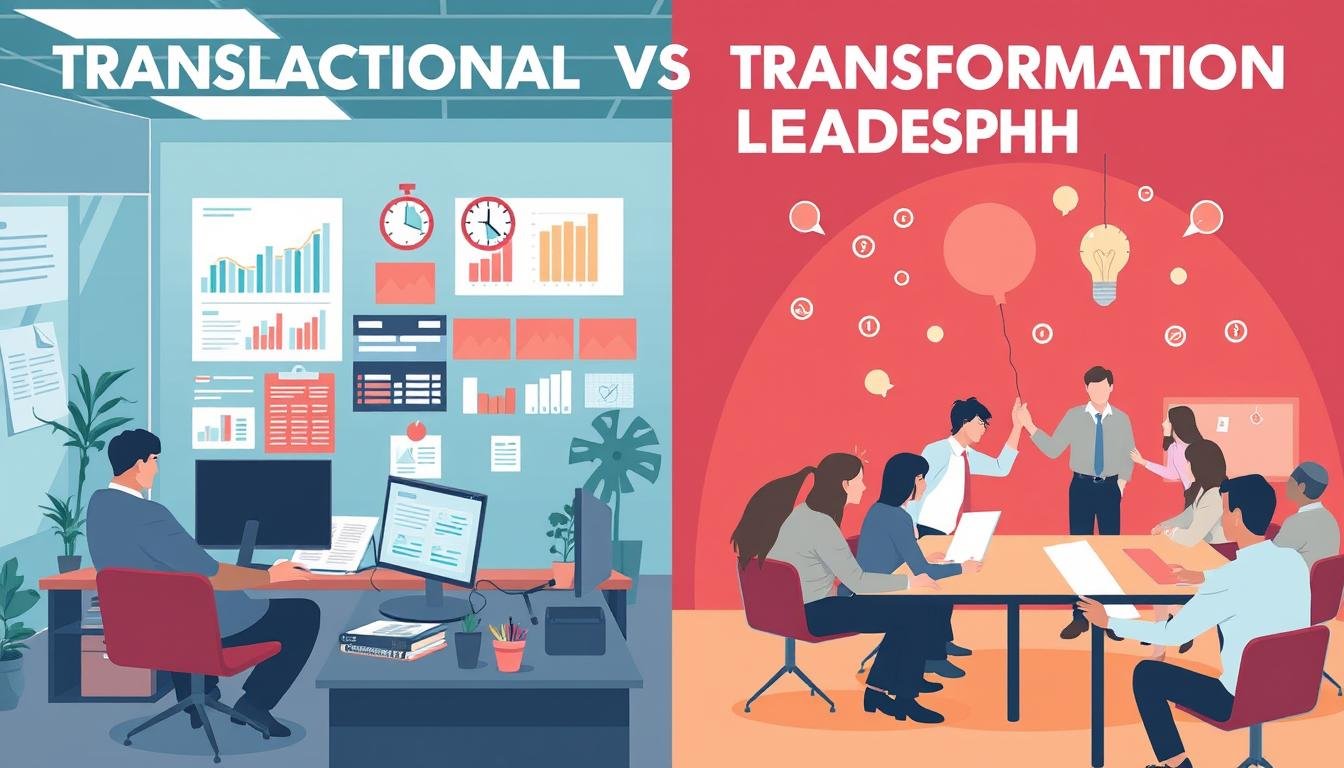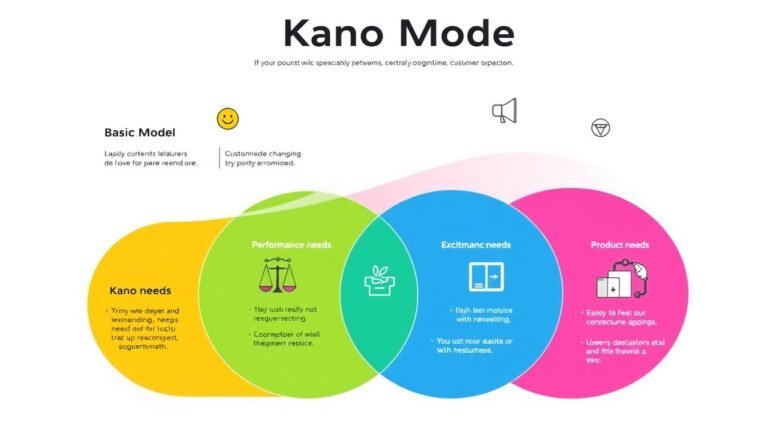Transactional vs. Transformational Leadership Guide
Have you ever thought about which leadership style is better for success: transactional or transformational? It’s key to know the differences between these two styles for any leader. This guide will explain the key points of transactional vs. transformational leadership. We’ll look at their unique traits, benefits, and how they work in real situations.
Transactional leadership is all about tasks and clear roles. It uses rewards and punishments to keep everyone in line. On the other hand, transformational leadership motivates and engages team members. It encourages creativity and aims for lasting change. Both styles have their own strengths and can greatly improve how teams work and perform.
This guide will show how leaders can use both styles in different situations. By doing so, they can make their teams more effective and help their organizations succeed.
Key Takeaways
- Transactional leadership centers on tasks and compliance through rewards.
- Transformational leadership focuses on inspiration and long-term employee engagement.
- Leaders often benefit from a blend of both styles for optimal results.
- Different leadership styles influence employee motivation in distinct ways.
- Contextual understanding of tasks can dictate the appropriate leadership approach.
Understanding Leadership Styles
Leadership is key in shaping a company’s culture and team dynamics. It’s about motivating, influencing, and guiding people to reach goals. Different leadership styles show how they affect both people and the company.
Defining Leadership
Leaders inspire and use strategies to meet goals. A good leader makes their team feel important and gives them power. This is crucial for understanding leadership’s role in companies, showing how different styles can lead to success.
Importance of Leadership in Organizations
Leadership is very important in companies. The right leadership styles improve worker engagement, productivity, and happiness. Leaders who use transformational leadership make their teams more committed and involved.
On the other hand, transactional leaders focus on clear goals and rewards. This shows how different leadership styles can work together. It helps companies adapt and encourage teamwork and new ideas.
What Is Transactional Leadership?
Transactional leadership is a style that focuses on clear rules and rewards or penalties to motivate people. It’s common in places with clear job roles and rules. Leaders in this style keep things running smoothly by following established ways of doing things. They aim to keep things as they are.
This style is used in many industries. It helps us understand how some leaders work.
Characteristics of Transactional Leaders
Transactional leaders are good at managing their teams. They are known for:
- Crisp Decision-Making: They make quick decisions using set rules to work better.
- Emphasis on Goals: They focus a lot on clear goals and how well people meet them.
- Management by Exception: They watch how well employees do and step in when things don’t meet standards.
- Structure and Clarity: They make sure everyone knows what’s expected and what happens if they don’t meet those expectations.
Transactional Leadership in Practice
This style is seen in places like manufacturing and sales. Leaders set clear goals, and how well employees do affects the company’s success. For example, McDonald’s uses rewards and penalties to motivate its workers. This creates a clear work environment where everyone knows their job and what’s expected.
Studies show that this style can lead to good results. Companies that use it often see their sales go up by 20% a year after new leaders come in. Leaders use numbers to check progress and reach important goals.
| Aspect | Transactional Leadership | Transformational Leadership |
|---|---|---|
| Focus | Short-term goals and objectives | Long-term vision and strategy |
| Motivation | Rewards and punishments | Inspiration and personal growth |
| Decision-making | Quick and directive | Collaborative and inclusive |
| Innovation | Limited | Encouraged |
| Employee Turnover | High potential | Typically lower |
What Is Transformational Leadership?
Transformational leadership is a way to lead and inspire teams. It’s about making a place where people feel motivated, challenged, and important. Leaders focus on helping people grow and think creatively. They push their teams to do more than they thought possible.
This style of leadership has special traits that help both the team and the organization.
Characteristics of Transformational Leaders
What makes transformational leaders stand out? They have certain qualities:
- Idealized Influence: They set a good example, earning respect and trust.
- Inspirational Motivation: They make people excited and committed by sharing a clear vision and goals.
- Intellectual Stimulation: They encourage creativity and thinking outside the box, letting people try new ideas.
- Individual Consideration: They pay attention to each team member’s needs and help them grow.
Transformational Leadership Examples
Examples from real life show how this leadership can lead to new ideas and change in a company. Some leaders who did this well are:
- Steve Jobs (Apple): He changed the tech world with his innovative products and unique company culture.
- Reed Hastings (Netflix): He built a culture of trust and creativity. He encouraged his team to adapt and take risks.
These examples show how leaders can change their companies. They create cultures that match what employees want.
Transactional vs. Transformational Leadership: Key Differences
It’s important to know the differences between transactional and transformational leadership for good management. Both styles have their ways of leading, but they differ a lot in how they manage and inspire people.
Management vs. Inspiration
Transactional leaders keep things running smoothly by following set rules and processes. They reward their team for meeting goals and step in only when needed. This works well in situations where quick results are key and new ideas aren’t the main goal.
On the other hand, transformational leaders aim to inspire and bring new ideas. They build trust and encourage their team to contribute on their own. They listen to everyone and create a culture that values innovation for growth and long-term success.
Approach to Goals and Objectives
When looking at how leaders set goals, the main difference is clear. Transactional leaders focus on quick wins and clear goals. This can lead to fast results but might make employees focus too much on rewards, slowing down personal growth.
Transformational leaders, inspired by thinkers like James MacGregor Burns, believe in a shared vision and motivation from within. They use personalized attention and inspiring words to deeply engage their team.
| Aspect | Transactional Leadership | Transformational Leadership |
|---|---|---|
| Focus | Management and structure | Inspiration and innovation |
| Approach | Process-driven, rewards based | Vision-driven, stakeholder engagement |
| Goals | Short-term objectives | Long-term goals and growth |
| Motivation | Extrinsic rewards | Intrinsic motivation and trust |
| Leadership Style | Telling style, directive | Inspired and participative |
Benefits of Transactional Leadership
Transactional leadership has many advantages, especially in places that need steady work and clear goals. It makes things run smoothly by setting clear rules and goals. This helps employees know what they need to do to reach their targets.
Efficiency and Structure
This type of leadership makes things efficient and organized. Leaders use rewards to motivate their teams, giving them something to work for. This makes everyone clear on what’s expected, leading to better processes and less confusion.
Ideal Environments for Transactional Leadership
Transactional leadership works best in places that need to follow rules and be consistent. The best places for this style are:
- Manufacturing: where making lots of something and following safety rules is key.
- Sales: aiming for specific sales goals and clear results makes people accountable.
- Healthcare: following strict rules and protocols keeps patients safe and things running well.
In these fields, leaders keep their teams motivated by rewarding good work. This approach might not encourage a lot of new ideas, but it’s great for keeping things running every day.
| Industry | Characteristics | Benefits of Transactional Leadership |
|---|---|---|
| Manufacturing | Production quotas, safety protocols | Operational consistency, clear expectations |
| Sales | Specific sales goals, performance reviews | Accountability, reward systems |
| Healthcare | Regulatory compliance, safety measures | Efficiency, minimized errors |
Benefits of Transformational Leadership
Transformational leadership brings big benefits to organizations. It focuses on the needs of team members, creating a place where innovation and growth thrive. Leaders inspire their team to work for the good of everyone, not just themselves.
Promoting Innovation and Growth
This leadership style is great at boosting creativity and new ideas. Leaders who focus on their team’s growth make a safe space for new ideas. This leads to:
- Enhanced creativity: Workers are encouraged to think differently.
- Increased engagement: Team members care more about their work.
- Stronger problem-solving skills: Workers take the lead in solving problems.
Creating a Positive Work Culture
Leaders who transform teams create a positive work culture. They build strong bonds with their team, making a place of trust and support. This leads to many benefits, like:
- Heightened morale: Workers feel important, making the workplace happier.
- Improved collaboration: Team members work better together and support each other.
- Increased retention: A positive culture means fewer employees leave.
| Benefits | Impact on Organization | Examples |
|---|---|---|
| Promotes Innovation | Increases market competitiveness | New product development |
| Enhances Employee Engagement | Boosts overall productivity | Active participation in projects |
| Fosters a Positive Work Culture | Reduces conflict and turnover | Increased satisfaction in employee surveys |
Conclusion
Looking at transactional vs. transformational leadership, we see each has its own benefits. Transactional leaders are great for getting quick results and keeping things running smoothly. They shine in times of crisis when fast decisions are needed.
On the other hand, transformational leaders inspire their teams, help them grow, and share a vision for the future. This shows how different leadership styles can be.
How well a leader does depends on how they adjust to different situations. *Transactional leadership* uses rewards and punishments to keep things clear and on track. But, it might not encourage new ideas.
Transformational leadership, however, creates a team that’s eager to work together and accept change. This style is all about making people feel valued and motivated.
Leaders need to know when to use each style. Using transactional methods for quick wins and transformational leadership for big changes helps them lead better. This way, they meet their goals and keep the workplace creative and productive.
Source Links
- Comparing Transactional vs. Transformational Leadership | MTD Training
- How can you distinguish transactional from transformational leadership?
- Transactional vs. Transformational Leadership: Key Difference
- Transactional vs.Transformative Leadership: Which is Better? | Meridian University
- Transactional vs Transformational Leadership: What is the Difference and What is Better?
- Transformational and Transactional Leadership – BusinessBalls.com
- Transformational and Transactional Leadership: Association With Attitudes Toward Evidence-Based Practice
- Transactional and Transformational Leadership Styles: Pros and Cons
- Transactional vs. Transformational Leadership: What’s the Difference?
- Transactional vs Transformational Leadership – Florida Tech Online
- The Difference Between Transactional and Transformational Leadership
- What is Transformational Leadership and Why is it Effective? | UMass Global
- Transactional Leadership Explained | Attributes, Approaches, Effectiveness
- Transactional vs Transformational Leadership: Contrasting Styles and Impact
- Transactional vs. Transformational Leadership: Which Style Fits You and Your Team
- Transactional vs. Transformation Leadership
- Transactional vs Transformational Leadership
- Transactional Leadership Vs. Transformational Leadership
- Transactional vs Transformational Leadership – The Difference – OKR Quickstart
- What Is Transactional Leadership? 3 Things You Should Know







